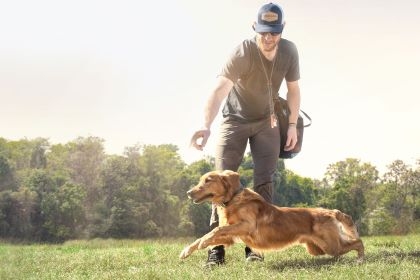Exercise-Induced HRI: Does Your Dog Need Help?

If you want your dogs to be sharp on Opening Day, you’ll have to run them in the summer. But hot temperatures and high humidity can make it difficult. A gun dog’s drive may override his ability to know he’s overheating, so it’s up to every owner and handler to keep their dogs safe.
Sponsored Content from Eukanuba™
Exercise-Induced HRI: Does Your Dog Need Help?
Written by Eukanuba Staff
If you want your dogs to be sharp on Opening Day, you’ll have to run them in the summer. But hot temperatures and high humidity can make it difficult. A gun dog’s drive may override his ability to know he’s overheating, so it’s up to every owner and handler to keep their dogs safe.
Know What to Look For
Running dogs in the summer means they may heat up faster than they can cool down. When a dog’s activity causes his body to generate more heat than he can dissipate he’s at risk of developing exertional or exercise-induced Heat Related Illness (HRI). Knowing the signs of HRI can help owners quickly respond to get dogs the help they need.
A dog’s normal core body temperature range is between 99.5-102.5 degrees. That range accounts for different breeds, sizes, weights, ages, and condition, among other variables. When they’re working in the summer their core body temperature can rise above the normal range. The hot, humid weather makes it challenging for dogs to cool off. If their internal heat rises faster than they can cool then they may start to show signs from one of the three stages of HRI: heat stress, heat exhaustion, and heat stroke.
Every dog handles heat differently. Those not properly acclimated or conditioned could show signs faster than those that are fit and in good shape. Heat stress is the first stage and dogs may be noticeably more tired, run at a slower pace, and show a lack of focus. With the next stage, heat exhaustion, handlers may see dogs weaken and stumble. In the third stage, heat stroke, owners may see signs similar to heat stress or heat exhaustion along with vomiting, diarrhea, confusion, and even collapse, among others.
If you believe your dog is showing signs of HRI then a call to a veterinarian for advice should be a priority. The chart below outlines some additional warning signs of the three stages of HRI as well as ways owners can help their dog cool down.
STAGE 1 – HEAT STRESS

STAGE 2 – HEAT EXHAUSTION

STAGE 3 – HEAT STROKE

If arriving successfully on Opening Day is our goal then training in the summer is key. To get there together we’ll need to work as a team. Dogs don’t know that heat can hurt, but owners and handlers do. The responsibility is on us to help keep our dogs safe while running in the heat and humidity.
 Optimal training times are when the temperature plus the humidity is under 140.
Optimal training times are when the temperature plus the humidity is under 140.
 Hard running bird dogs need plenty of water breaks in the summer.
Hard running bird dogs need plenty of water breaks in the summer. In between sets, give dogs a rest in a shady area.
In between sets, give dogs a rest in a shady area.
 Gun dogs running in high elevations and in loose shale makes them work hard. Take breaks to help cool them down.
Gun dogs running in high elevations and in loose shale makes them work hard. Take breaks to help cool them down.

Irwin Greenstein is Publisher of Shotgun Life. Please send your comments to letters@shotgunlife.com.


Comments